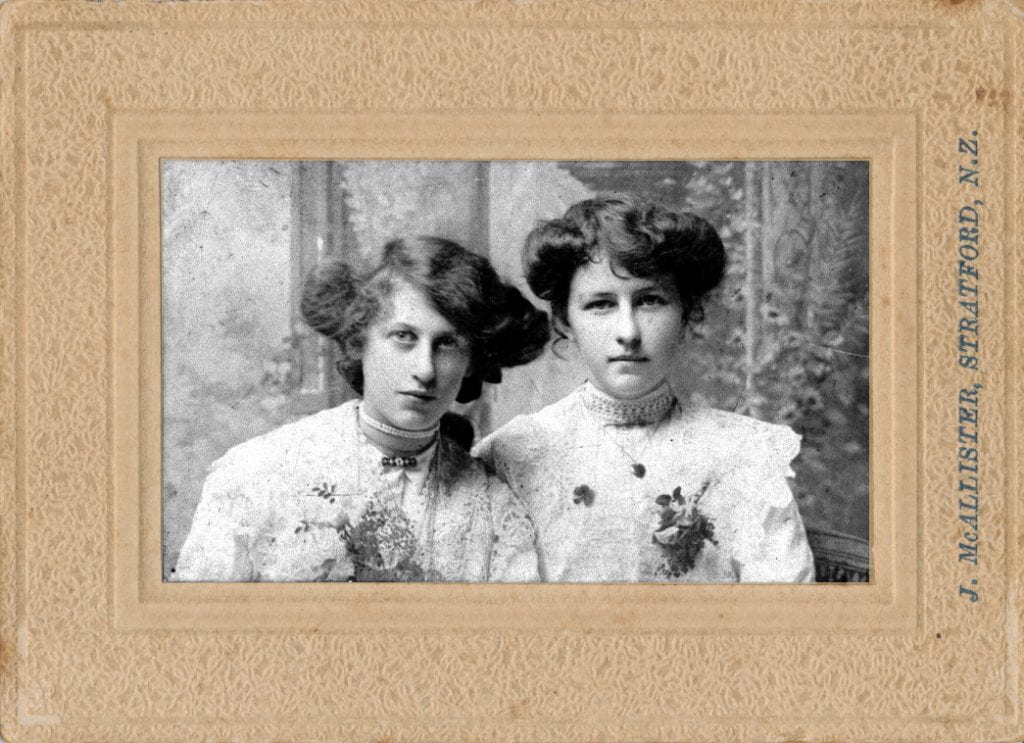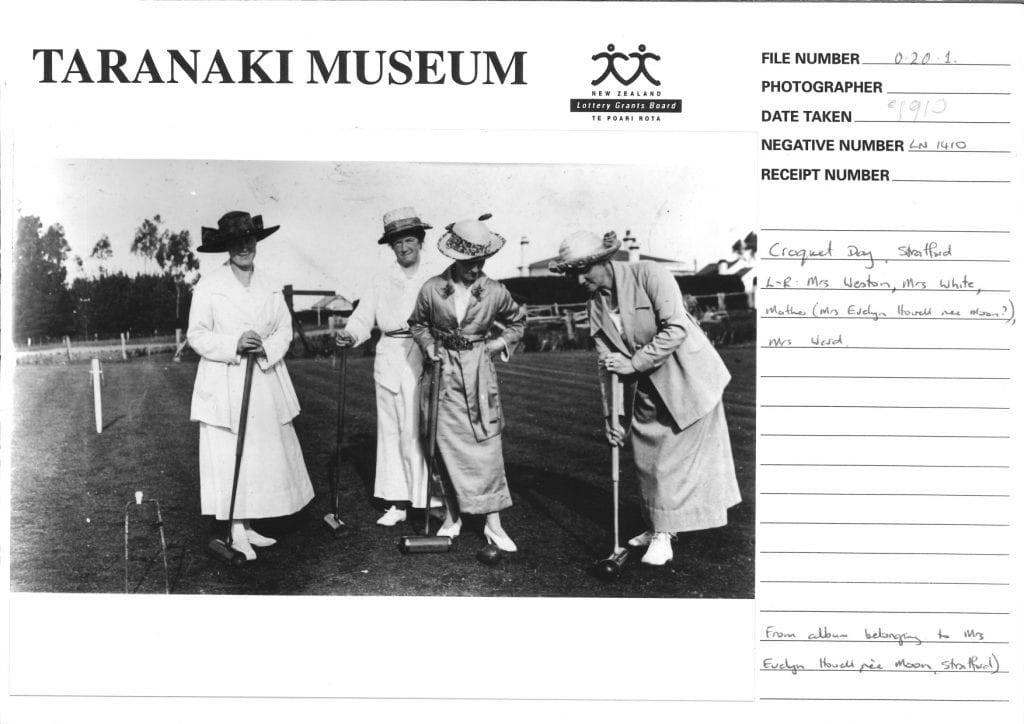Sometimes the voice comes from a long way off but it can still make powerful connections. In one of Sue Needham’s folders is a retyping of her cousin Graeme Griffin’s typed transcript of a letter written by Dorothy Moore (1896-1979) to her sister Constance around 1910. Dot, aged about 13, is writing home to Lismore, NSW, from New Zealand where she is visiting her Moore relatives. She has just arrived in Stratford, 30 miles south of New Plymouth:
Dear Concie,
I arrived in Stratford safely on Sunday. Aunty Ruth was down at the station to meet me. Aunty Grace was up in the town doing some shopping. Aunty Ruth drove me home to take all the luggage because Aunty Grace could not get in with the luggage. We came back in town then Aunty Grace was down playing croaky [sic] so we went down there. Both Aunty Ruth and Grace play croaky. They go down to play twice or three times a week. Uncle George is so big and fat, a lot fatter than Dad. He is also a bit of a hard case. Aunty Grace has three cats and two kittens. I will name them Mary, Black Puss and Tabby. She has no name for the kittens yet. She had a cat called B…[torn]. What names you will say I expect I wi…[torn] going to Fielding next Wednesday so.. I will write home then and tell mother and you and Frances what Deslie [?] and Lelia are like. Today Aunty Grace is at a flower show down the line somewhere. She is [sic] put a little floral bonnet in. It is made of daisies and two cream cassus [?] dahlias for the rosette. It looks very pretty. I do not know if she got a prize for it or not but I will tell Frances tomorrow if she has. She is also arranging flowers for a table. Dear old Topsy how are you getting on at school. I hope you are in third class now. Is Toby still in fourth or is she in fifth? Does Annie Black go to the public school? Write over and tell me all the news. Dear Topsy you just aught to see the flowers Aunty Grace has. Oh she has such a lovely lot. Tell Mum she has a lot of the real asters. She has double and single. No more news this time.
I remain
Your Loving
Sister Dot
The flower show and Dot’s questions about which classes her younger sisters are in point to a late summer date, perhaps late January or early February. Dot herself may have left school after finishing sixth class to visit her New Zealand family before returning to Lismore to start her first job in a local florist shop. Perhaps she has already been to New Plymouth to see her grandparents Alfred and Catherine Moore in their home at present-day 355 Devon St East. Now she is meeting aunts Ruth Moore and Ella Grace Hobbs, and Grace’s husband George Hobbs (fatter than her own father Harry and a bit of a hard case). The family penchant for gardening and exhibiting in local horticultural shows is alive and well in Dot and her aunts. She shares her knowledge of flowers with Concie and makes special mention of Grace’s daisy and créme de cassis’ dahlia decorations for a floral bonnet. Créme de cassis’ dahlias have two-toned petals, soft lilac-pink on the top and plum-coloured below.
George and Grace Hobbs live on Mountain Rd, which runs north and south of Stratford and was then as now the main road south. Electoral rolls tell us that Ruth is living with her married sister. Dot’s letter tells us that her aunts enjoy a game of croquet in town. Do the sisters shop at the drapery on Broadway owned by Cornelius O’Leary? Do they know Cornelius’s daughters Bessie and Claribel May? Do they know the widow Mrs Elizabeth Evans of Regan St and her youngest son Edward Douglas, known as Argoyd? Stratford, then as now, is a small town. Michele’s Evans and O’Leary grandparents Argoyd and May, as yet unmarried, are part of town life, frequenting the same church bazaars, bowling clubs and croquet greens, exhibiting in the same flower and craft shows. Argoyd Evans is a cabinetmaker with a talent for wood carving. He will marry and establish ED Evans, Furnishers, in Stratford after his return from the war in 1919.

Dot is moving on by train to visit her uncle Frank Edwin and aunt Minnie Hill Moore in Fielding. She promises to report to Concie about their cousins Deslie (5) and Lela (2). From Fielding it seems likely she will continue by train to Wellington and perhaps cross the strait to visit her great aunt Emily in Nelson before returning to Sydney.
What is so special about Dot’s letter? First, it has been preserved by the Australian family, and though the handwritten original has disappeared, Dot’s words have come down to us, confirming that Harry Moore’s family crossed the Tasman in another generation to keep up contact with their New Zealand relatives. Now we can better understand Dot’s 1969-1972 correspondence with her second cousin Phil Briant. It is even possible that Dot got off the train in Marton to meet the Briants who were sheep farming at nearby Bonnie Glen. If this is the case, Phil would have been 8 and his brother Goff 7.
Many parts of our written history disappear as decades roll on and families disperse. Dot’s 1910 letter from Taranaki is a little bit of family Gondwana connecting the New Zealand Harris descendants and their Australian cousins.

Lead writer: Michele Leggott
Research support: Makyla Curtis, Betty Davis